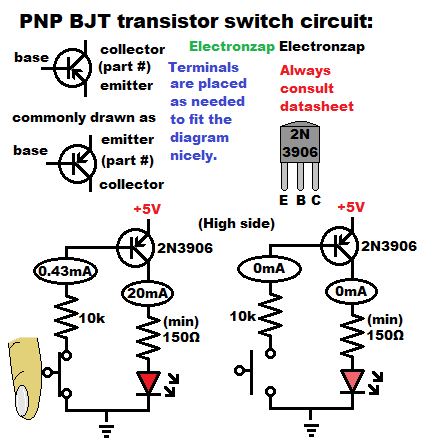Table of Contents
PNP BJT switches have current that flows in the opposite direction of NPN BJT switch circuits.

The PNP Bipolar Junction Transistor (BJT) emitter is connected to the positive supply (Vcc).
From there, the current splits into 2 paths. The Emitter to base (control) and Emitter to Collector (controlled).
A little bit of current needs to flow through the Emitter to Base, by pressing the switch, before a lot more current will flow from Emitter to Collector.
You can expect a 2N3906 PNP BJT to have a gain of more than 100 in most circumstances.
With a 5V power supply, the LED with protective resistor load in this circuits wants 20 mA of current. That is the maximum current for most indicator LEDs. A practical circuit should use a higher value protective resistor to limit the current to 10 to 15 mA.
If we consider a gain of 100 (worse case scenario) then we want at least 0.2mA of current flowing from Emitter to Base when we turn the transistor on in this circuit. That is because 0.2mA times 100 equals 20mA.
The Emitter to Base “diode” drops approx. 0.7V from the resistor that is in series with the Base. That gives 5V supply minus 0.7V equals 4.3V across the 10,000Ω resistor that sets the current through the base when the switch is pressed. 4.3V across the resistor, divided by 10,000Ω gives us approx. 0.43mA of current flowing through the Emitter to Base. Allowing 43mA, likely much more, to flow from Emitter to Collector. There is no diode drop to worry about from Emitter to Collector current. It only builds up from Emitter to Base.
Since the load limits the current to 20mA, the transistor is considered as conducting fully since it will allow a lot more. BJTs conducting fully is known as saturation.
To support this site, check out the following links:
- Check out my YouTube videos! https://www.youtube.com/c/Electronzap/videos
- Products I used in my videos or otherwise think look like a good buy. As an Amazon associate, I earn from qualifying purchases. https://www.amazon.com/shop/electronzapdotcom
- Information on this site is not guaranteed to be accurate. Always consult the manufacturer info/datasheet of parts you use. Research the proper safety precautions for everything you do.
- Electronzap is a participant in the Amazon Services LLC Associates Program, an affiliate advertising program designed to provide a means for sites to earn advertising fees by advertising and linking to amazon.com.